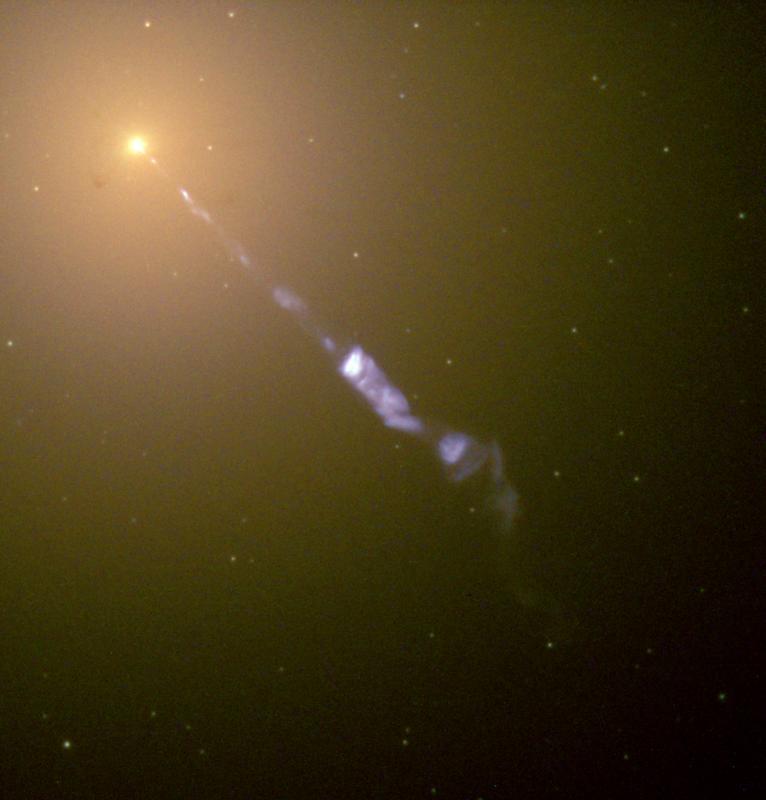







| BOOKS | F. A. Q. | ARTICLES | TALKS | ABOUT KEN | DONATE | BEYOND OUR KEN |
|---|
By Ken Croswell
Published on PhysicsWorld.com (May 25, 2010)

Image of M87 by the Hubble Space Telescope. NASA and the Hubble Heritage
Team (STScI/AURA).
Astronomers in Germany and the U.S. have uncovered a startling correlation that could provide important insights into how galaxies form and evolve. The scientists found that the bigger the black hole at an elliptical galaxy's center, the more globular star clusters the galaxy has.
Most large galaxies, including our own, have a supermassive black hole at their center. They also have globular clusters--tight-packed spheres of ancient stars. But the clusters usually lie far from the center, so discovering a link between the two is akin to finding that the height of a city's tallest skyscraper matches the number of trees in the surrounding countryside.
"People have tried to make correlations of black hole mass with obvious properties," says Andreas Burkert at the University of Munich. "And then we thought, `Why not try something which is out of thin air--where nobody would think there should be any correlation?'"
Burkert and Scott Tremaine at the Institute for Advanced Study in Princeton, New Jersey, studied 13 galaxies "just for the fun of it," he says. Nine were giant elliptical galaxies, including M87, the central galaxy in the Virgo cluster. One galaxy was a tightly wound spiral, and three others were S0 galaxies--which are crosses between elliptical and spiral galaxies.
To the scientists' surprise, all 13 galaxies obeyed a correlation between black hole mass and globular cluster number that was even tighter than other known correlations with black hole mass.
"I think this correlation is telling us something fundamental," says John Kormendy of the University of Texas at Austin, who was not involved with the work. "That it's such a good correlation suggests that the formation of globular clusters and the growth of black holes were connected." Because globular clusters and giant elliptical galaxies are made of ancient stars, Kormendy says the link between them likely originated in special conditions that existed shortly after the big bang.
Burkert and Tremaine suggest that the correlation may arise from galactic collisions. When gas-rich galaxies collide, gas falls into the central black holes, upping their mass. Such collisions also create globular clusters, as astronomers see in the constellation Corvus, where two spiral galaxies named the Antennae are smashing together.
"I find this very exciting," says Jeremiah Ostriker of Princeton University, another astronomer not involved with the new work. "It may be giving us a clue as to how black holes are formed at the centers of galaxies."
Ostriker offers a different theory to explain the correlation. As globular clusters revolve around a galaxy, they pass through its dark matter, which robs them of orbital energy via a process called dynamical friction. Ultimately the globular clusters sink into the galaxy's central black hole, increasing its mass. Thus, says Ostriker, the more globular clusters a galaxy has to begin with, the more get destroyed and the greater should be the mass of its central black hole, just as Burkert and Tremaine have found.
Burkert and Tremaine say that the correlation is not merely a reflection of a galaxy's size or luminosity. For example, M87 has a huge black hole weighing 6 billion times more than the Sun, and an equally impressive number of globular clusters--a whopping 15,000--spread over hundreds of thousands of light-years. In contrast, another giant galaxy, Fornax A, emits as much light as M87, but its central black hole has only 150 million solar masses and its globular clusters number just 1200.
The newfound correlation does not apply to our Galaxy, however, because the Milky Way is a loosely wound spiral. As a result, its modest, 4-million-solar-mass black hole implies far fewer globular clusters than the approximately 160 it possesses. By contrast, Burkert and Tremaine say the more tightly wound spiral galaxy Andromeda, which was not part of their original sample, does obey the correlation.
This work has been submitted to The Astrophysical Journal.
Ken Croswell is an astronomer and author based in the U.S.
| BOOKS | F. A. Q. | ARTICLES | TALKS | ABOUT KEN | DONATE | BEYOND OUR KEN |
|---|